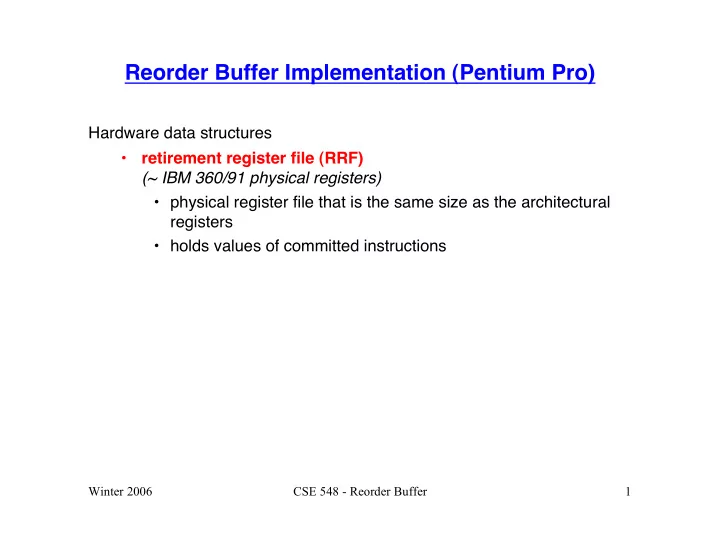

Reorder Buffer Implementation (Pentium Pro) Hardware data structures • retirement register file (RRF) (~ IBM 360/91 physical registers) • physical register file that is the same size as the architectural registers • holds values of committed instructions Winter 2006 CSE 548 - Reorder Buffer 1
Reorder Buffer Implementation (Pentium Pro) Hardware data structures • reorder buffer (ROB) (~ R10K active list) • provides in-order instruction commit • circular queue with head & tail pointers • holds 40 “executing” instructions in program order (dispatched but not yet committed) • field for either integer or FP result after it has been computed • a result value is put in its register in the RRF after its producing instruction has committed (i.e., reaches the head of the buffer & is removed) Winter 2006 CSE 548 - Reorder Buffer 2
Reorder Buffer Implementation (Pentium Pro) Hardware data structures • register alias table (RAT) (~ R10K map table) • provides register renaming • important because very few GPRs in the x86 architecture • indicates whether a source operand of a new instruction points to the reorder buffer or the physical register file • do an associative search of ROB destination registers for the new source operands • if found, consumer instruction points to the producer instruction in the ROB • the data hazard check before instruction dispatch Winter 2006 CSE 548 - Reorder Buffer 3
Reorder Buffer Implementation (Pentium Pro) Hardware data structures • reservation station (~ IBM 360/91 reservation stations, R10000 instruction queues) • holds instructions waiting to execute • provides forwarding to reduce RAW hazards • result values go back to the reservation station (as well as ROB) so dependent instructions have source operand values • provides out-of-order execution Winter 2006 CSE 548 - Reorder Buffer 4
Winter 2006 CSE 548 - Reorder Buffer 5
Pentium Pro Execution In-order issue • decode instructions • rename registers via register alias table • enter uops into reorder buffer for in-order completion • detect structural hazards for reservation station Out-of-order execution • one reservation station, multiple entries • check source operands for RAW hazards • check structural hazards for separate integer, FP, memory units • execute instruction • result goes to reservation station & reorder buffer In-order commit • this & previous uops have completed • write “G”PR registers • rollback on interrupts Winter 2006 CSE 548 - Reorder Buffer 6
Pentium Pro fetch & decode pipeline BTB access (1 stage) instruction fetch & align for decoding (2.5 stages) decode & uop generation (2.5 stages) register renaming & instruction issue to reservation stations (3 stages minimum) integer pipeline execute, resolve branch write registers & commit load pipeline address calculation & to memory reorder buffer integrated L1 & L2 data cache access pipelined FP add & multiply Winter 2006 CSE 548 - Reorder Buffer 7
Pentium Pro Winter 2006 CSE 548 - Reorder Buffer 8
Pentium Pro Winter 2006 CSE 548 - Reorder Buffer 9
Pentium Pro Some bandwidth constraints: maximum for one cycle • 16 bytes fetched • 3 instructions decoded • 6 µ ops issued to the reorder buffer • 3 µ ops dispatched to reservation station & functional units • 1 load & 1 store access to the L1 data cache • 1 cache result returned • 3 µ ops committed if • good instruction mix • right instruction order • operands available • functional units available • load & store to different cache banks • all previous instructions already committed Winter 2006 CSE 548 - Reorder Buffer 10
Pool of Physical Registers vs. Reorder Buffer Think about the advantages and disadvantages of these implementations • book claims that physical register commit is simpler • record that value no longer speculative in register busy table • unmap previous mapping for the architectural register • instruction issue simpler (physical register pool) • only look in one place for the source operands (the physical register file) • book claims that deallocating register is more complicated with a physical register pool • have to search for outstanding uses in the active list • but not done in practice: wait until the instruction that redefines the architectural register commits • faster to index map table to get source operands than do associative search on ROB • can have more outstanding results Winter 2006 CSE 548 - Reorder Buffer 11
Limits Limits on out-of-order execution • amount of ILP in the code • scheduling window size • need to do associative searches & its effect on cycle time • relatively few instructions in window • number & types of functional units • number of ports to memory Winter 2006 CSE 548 - Reorder Buffer 12
Recommend
More recommend